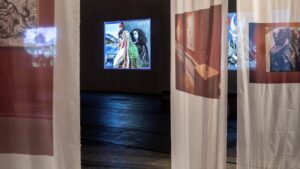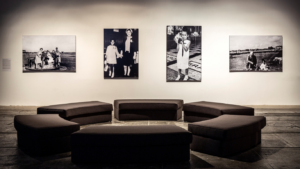This week we travelled to Glasgow to visit exhibitions and find inspiration for our curatorial project.
After visiting Maud Sulter’s exhibition ‘You are my kindred spirit’ in Glasgow, I had a profound shift in my curatorial direction. Initially, my curatorial vision was for an exhibition that explored ‘disembodied language’ – a sensory spatial experience that attempted to break free from the logical constraints of words and language, with an emphasis on non-verbal mediums such as sound, smell and touch. However, in the course of preparation, I gradually realised that the limitations of the venue and budgetary resources made it difficult to realise this idea. In particular, the combination of the feeds made me doubt the fundamental significance of my curatorial approach. Just when I was feeling stuck, I was unexpectedly inspired by the work of Maud Sulter.
The exhibition is not ambitious, but it has great depth. It weaves a space of multiple perspectives on identity and history through video, sound, poetry readings and archival material. In particular, Sulter’s work crosses mediums to reveal how black women have been seen, erased, and poetically and politically reclaimed that part of their voice and image in art history and social structures. I was struck by the fact that she does not attempt to ‘disengage’ from language, but rather creates an intertwined narrative between language and the body – her language is not a tool of power, but rather a restoration and a call to action. Her voice recordings, home videos, and texts are superimposed on images, not to explain, but to awaken an emotional resonance.
Sulter’s voice echoed vibrationally through the space. Her recitation of ‘Alba Sonnets,’ about the emotional experiences of two black women at the Scottish court in the 16th century, was low and unadorned, filling the gallery like a ghost. I realised that language is not just a product of the rational world, but can also be an introduction to emotion, an echo of history, an extension of the body. Even in the absence of the body, sound can awaken the faces of women that have been erased by history, and although the bodies of Elen and Margaret are not directly presented in the works, their voices become the dominant force in the space. The belief that ‘to hear them is to let them live’ deeply shook me. I realised that language is not my curatorial enemy; on the contrary, in some contexts, language itself is the site of resistance.I am reminded of Christina Sharpe’s ‘wake work’ in In the Wake: On Blackness and Being (2016) – bringing back to the present the ghosts, the erased, of history through image and sound to create a ‘non-archival presence’ for them. In the Wake: On Blackness and Being (2016), I am reminded of Christina Sharpe’s ‘wake work’ – bringing the ghosts of history and the erased back into the present, creating a ‘non-archival presence’ for them through image and sound.

You are my kindred spirit
As a result, my curatorial direction began to change completely. I am no longer obsessed with ‘escaping from language’, I began to turn to the theme of the female body, focusing on those female figures that have been objectified, mystified, and used as allegorical carriers in history and art, and attempting to curate an exhibition that will allow the female body to speak again, rather than being spoken to again. At my current academic level, it is too challenging to curate an exhibition that gets rid of language. I can choose not to get rid of language, but to choose whose language to speak in; not to erase the body, but to decide what kind of body to appear in. She uses poetry, images and sound to establish pathways to the present for the silenced, and made me realise that the reconstruction of the female body in art is not a return to sensory primitives, but a profoundly political and emotional reorientation. The significance of curating is perhaps in this constant repositioning, finding ways for others to be seen and heard.
Therefore, I began to turn to a more specific direction: curating around the stigmatisation and reconstruction of the female body in art. The female body is not a carrier of a single meaning; it is an aggregation of experience, history, culture and emotion. The way she connects her mother, family, hometown and body opens up a new path for me – an exhibition that has a political edge but also retains poetic expression. Instead of focusing on abstract ‘de-lingualisation’, I began to pay attention to how the repressed create their own language, how they speak out through art, and how curating can be a co-conspirator and amplifier of this voice.

You are my Kindred Spirit2
Maud Sulter inspired me not only to change the thematic direction of the exhibition, but also to reflect on my own position and responsibility as a curator. She is not ‘presenting’ herself, but rather ‘evoking’ a cross-generational emotional connection. I hope that my curatorial work can be like hers, a space of connection rather than interpretation, and an affectionate response to marginalised experiences.



Leave a Reply